In an interview conducted by Dr. Damon Adams, Dentistry Today’s editor-in-chief, Dr. David Hornbrook shares his opinions, knowledge, and vast clinical experience on what he feels are some of the hottest topics in dentistry today.
Dr. Hornbrook lectures internationally on all facets of aesthetic dentistry. He founded and was the past director of PAC~live and the Hornbrook Group. He is the past clinical editor of the Dental Practice Report, a member of the Esthetic Dentistry Research Group, which publishes REALITY and REALITY NOW, and is on the editorial boards of many of the leading dental journals. He is also the past editor of the Journal of the American Academy of Cosmetic Dentistry.
|
|
||
|
Dr. Adams: I’ve heard you say numerous times that this is the most exciting time in dentistry, because of all the changes that are occurring. In your opinion, what are the most exciting changes that we are currently witnessing?
Dr. Hornbrook: As I travel around the country and interact with other clinicians, laboratories, and manufacturers, I have found the 3 hottest topics today are metal-free indirect dentistry, prepless and minimal preparation veneers, and the use of lasers in dentistry. The technological changes taking place are truly revolutionizing the way we practice dentistry and the manner in which laboratories are fabricating restorations. Digital dentistry and the use of computer-aided design/computer-aided manufacturing (CAD/CAM) fabrication not only improves the quality and accuracy of the dentistry we do, it allows for faster turn around time and has overcome so many of the compromises we have seen with indirect dentistry in the past.
With the advancements in digital dentistry, we are seeing changes in how we take our impressions for indirect restorations. I personally think the traditional “squirt the material out of a gun and wait for it to set 5 minutes in a messy tray” is rapidly going to be a treatment modality of yesterday. I believe that few clinicians will be using “impression material” as we know it today, 5 years from now. Digital impressions are more accurate and comfortable for our patients. If you think about where our compromises in indirect dentistry arise from, they have their roots in the inaccuracy of polyvinyl impressions as well as in the pouring of the impressions in dental stone. If I can now scan the preparation instead of taking a traditional impression, and then either modem that scan to a milling machine I have in my office or directly to the laboratory, I have eliminated many of the potential errors. CEREC (Sirona) users have already been doing this for years with excellent results, but they were forced to endure a substantial initial cash outlay for the equipment. If doctors can now purchase a digital scanner, without the expense of an actual in-office milling machine, at a fifth of the cost, I think we are going to see much wider spread usage of this technology.
Laser technology has been used in dentistry of almost 2 decades, but it has not really been utilized as much as we have seen in the last few years, and probably what we can expect in the very near future. With lasers being produced with reduced cost and size, more reputable manufacturers getting involved, patient demand, and better and more controlled research; these are all reasons for the increase in laser popularity. I believe that the use of lasers in periodontal procedures will become a “standard of care.”
Dr. Adams: David, you mentioned prepless and minimal prep veneers. Why are these techniques such a hot topic at this time?
Dr. Hornbrook: I receive more questions about issues regarding prepless and minimal prep veneers than any other right now. The interest in these techniques is obviously consumer driven and the increased interest by clinicians is a direct result of their patients asking about these conservative treatment possibilities. This interest is primarily due to the fact that a major dental manufacturer went directly to the consumer and said, “You’ve got to have these.” Now the consumer, having read or seen marketing propaganda, comes to our office asking about treatment.
The concepts of prepless and minimal prep veneers have been around for many years, but it has not been until recently that we have seen such widespread interest among clinicians. Many clinicians placing veneers today were previously taught that they must do relatively aggressive preparations to yield acceptable aesthetic results. As a result, the ability to place aesthetic veneers without preparation is still a relatively new concept for most clinicians, yet they should be familiar with it. This is a huge paradigm shift for so many clinicians, including for me. Previously, we have always had the mindset that “if you are going to add something on the facial of the tooth, then you must remove something to make the room.”
Like many clinicians, I had quite a few patients who either declined treatment because they would not let me prep their teeth, or who never approached me because they were concerned about getting their teeth prepped. As I begun looking more closely at this technique, prior to really understanding how to make this work, I struggled with the fact that the nonprepped veneer cases that I had seen all looked bulky, ugly, and too opaque. I did not think that they were representative of the type of artistic dentistry that I wanted to provide. I realize now that those cases were a direct reflection of a lack of preplanning and designing the smile, incorrect use of materials, the quality of the ceramists used, and not necessarily because they were minimal in their preparation.
As dentists practicing in this new millennium, we need to look very closely at the techniques of prepless and minimally prepared veneers. We need to decide if these are services that we should offer to our patients, and if it will provide a good aesthetic result and a successful long-term prognosis. It’s important for clinicians to realize that there’s not just one certain brand of ceramic, one particular manufacturer, or one specific laboratory that can do your prepless veneer restorations. The prepless or minimal prep veneer is a technique, not a specific product. Any ceramic can be used, and there are many expert ceramists who can give you wonderful results.
Success with these techniques is reliant on the c
ommunication process with the laboratory technician and in case selection and diagnosis. Many clinicians I have spoken to, when the treatment is a traditionally prepped veneer case, spend a lot of time in the smile design process and write a very detailed laboratory prescription. Yet, when they do a nonpreparation case, they spend very little time in the design process. We need to design the case exactly like we would design any other veneer case. The process of diagnosis becomes even more important with minimal preparation cases—if you want to obtain predictable results. With prepless veneer cases, I have to have more input from my ceramist to see if a result can be delivered that will make both me and my patient happy.
In my opinion, many clinicians look at the prepless veneer as a “lesser” veneer, or cheaper veneer, because it is not prepped. Because of this, they use inferior laboratories, or are not as concerned about researching the best materials available. That a huge mistake! Some that I have spoken too even take alginate master impressions, pour-up the models in their office, and send them to the laboratory. Then, when the case is returned with ill fitting margins or compromised aesthetics, they blame the prepless technique for the subpar restorations.
With prepless or minimal prep cases, we must have an intimate relationship with our ceramist. Success is dependent on educating our ceramists, and getting them involved in utilizing the materials to do prepless or minimal prep veneers. The dental laboratory technicians need to give us input as to whether or not they can deliver acceptable results. I’ve had patients say, “I do not want my teeth prepped” and my response was, “I don’t know how aesthetic this is going to look; I think it’s going to look bulky or fake, or it’s not going to be something that looks like the pictures in my reception room.” I’ve have had cases where I have taken impressions and sent them off to the ceramist, despite the fact that I didn’t think it was going to look good, just to get their input. The ceramist, after reviewing the case, calls me back and says, “You’re kidding right? I can’t do this! It’s going to be bulky and ugly, and because this one tooth is flared, the entire case is going to be too far facial.” This is the kind of important input I want from my dental technicians.
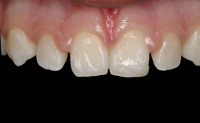 |
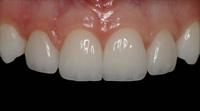 |
|
Figures 1 and 2. Before and after of a prepless veneer (Emprethin Veneers, emprethin.com) case, following orthodontics. |
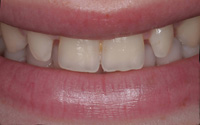 |
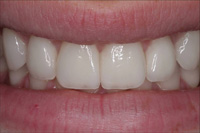 |
|
Figures 3 and 4. Before and after of a prepless veneer (Emprethin Veneers) case, following orthodontics and laser tissue recontouring. |
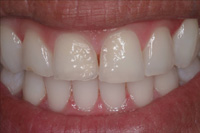 |
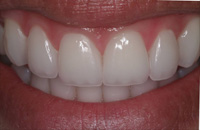 |
|
Figures 5 and 6. Before and after of a prepless veneer (Emprethin Veneers) case. The patient had a history of sucking on lemons as a child. |
Although prepless veneers are not indicated for every case, or even the majority of the cases, it certainly should be a part of every clinician’s restorative armamentarium. It is a great option on young adults or teenagers with microdontia, or postorthodontic treatment. Working with the orthodontist to align teeth correctly can yield excellent results (Figures 1 to 4). Many of these thin veneers are only 0.2 mm thick, so they can look natural and not overly bulky (Figures 5 and 6). Currently, I am using a leucite-reinforced pressed ceramic for my prepless veneers called Emprethins (emprethin.com), because I like the physical properties of this ceramic. The bottom line is to be educated and truly understand the indications and contraindications of this technique before attempting a case or dismissing it as not a possibility.
Dr. Adams: Metal-free dentistry has become a goal for so many clinicians. Are we to a point where one can truly eliminate metal from their restorative practice?
Dr. Hornbrook: We are almost there. Certainly, in direct dentistry, we can eliminate metal. The new composite resins, especially the low shrinkage, high wear resistant resins have become an excellent alternative to amalgam. They can be more conservative and actually strengthen and support the tooth, whereas amalgam has been shown to compromise tooth integrity. Obviously, technique sensitivity when placing resin restorations is higher than amalgams, but if a clinician is willing to take the time to practice excellent dentistry, the final results will be superior, in my opinion. For single tooth indirect dentistry, we can absolutely eliminate metal.
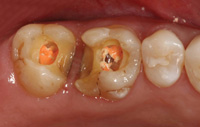 |
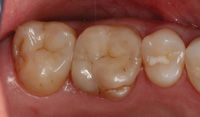 |
|
Figures 7 and 8. Intracoronal all-ceramic restorations were used to restore endodontically treated teeth. A fourth generation dentin (All Bond 3 [Bisco]) adhesive system was used to provide retention, and to support and strengthen the cusps. |
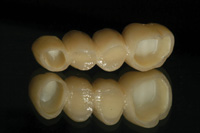 |
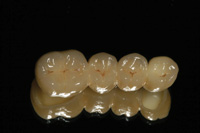 |
|
Figures 9 and 10. A 4-unit zirconium-oxide (Lava [3M ESPE]) supported (metal-free) bridge replacing missing mandibular premolars. |
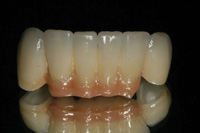 |
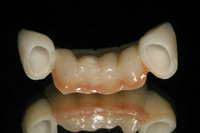 |
|
Figures 11 and 12. A 6-unit anterior (Everest [Kavo]) bridge supported with a zirconium oxide framework, replacing missing mandibular incisors. |
When treatment-planning indirect dentistry, all-ceramic crowns have proven to be an excellent alternative for metal-based restorations. The ability to adhesively bond many of the ceramic materials yield improved integrity and sealing of the margins, better resistance and retention, and improved aesthetics. A major advantage of using the adhesively-bonded metal-free restorations is the ability to be more conservative since most require only 1.0 mm thickness as compared to 1.5 to 2.0 mm for metal supported restorations; maintain our margins supragingival; and place more intracoronal restorations rather than be forced to wrap over cusps that were traditionally done with metal-supported restorations (Figures 7 and 8). The disadvantage of some of the all-ceramic materials, (ie, leucite reinforced and powder-liquid ceramics) is the need to adhesively bond them to place, which requires more attention to technique than we had been used to with metal-reinforced restorations. With the new high-strength ceramic copings, such as aluminum oxide and zirconium oxide, we can now traditionally cement metal-free restorations using the same cements that have always been used with metal. Although the zirconium oxide does introduce some opacity, and thus slightly compromises the aesthetic value of a restoration compared to bonded ceramics, we can achieve superior aesthetics compared to metal-supported restorations. These zirconium-supported ceramics can also be used for multiple-unit bridges, in both the anterior and posterior (Figures 9 to 12).
Nonmetal restorations can be used to replace metal-supported restorations in all instances, except if the clinician desires to place a precision or semi-precision attachment onto a crown to support a removable partial denture. While partial rests can be placed in all-ceramic crowns, female or male attachments cannot be incorporated into these, and a metal-reinforced crown would need to be utilized.
In my practice, I have eliminated metal almost completely. The only place that I currently use metal is in the implant body itself, and the screw that retains the all-ceramic abutment.
Dr. Adams: Other than the aesthetic advantages, what are other reasons that clinicians might be interested in finding and utilizing metal-free options.
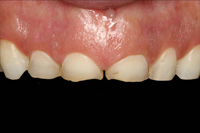 |
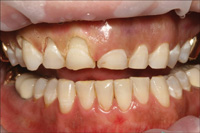 |
|
Figure 13. Preoperative photo showing short teeth, and the need for gingival recontouring to increase teeth length. |
Figure 14. Immediate postoperative photo of maxillary right, after osseous recontouring. Gingival tissue was recontoured, and approximately 3.0 mm of bone was removed via laser recontouring. |
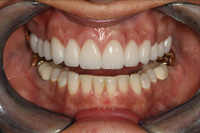 |
|
Figure 15. Two month postoperative photo, following osseous recontouring and veneer placement. |
Dr. Hornbrook: I already mentioned conservation of tooth structure, which I think is one of the major advantages. Another advantage is certainly metal toxicity, especially when using nonprecious metals in many of these restorations. We know that a majority of our patients have some negative reaction to nonprecious metals such as nickel and beryllium. In my opinion, as we see more of our indirect dentistry being fabricated by overseas laboratories, we may potentially see an increase in problems with the metals being used. We are also going to see galvanic reactions between the different metals used in the mouth, thus potentially compromising both tooth and gingival health. My stance on this is that if we have an option to use a metal-free restoration, we should do so.
Dr. Adams: You mentioned digital impressions earlier. Do you think the use of digital impressions is going to overtake the use of physical impressions, and what will be the hurdles for dentists in adopting this new technology?
Dr. Hornbrook: As I mentioned earlier, in the very near future, digital impressions will replace traditional impressions for most astute clinicians. It just makes sense in terms of accuracy and ease. It will be a less expensive option in the long run. The dental laboratory technicians are embracing this technology because of its accuracy, and the ability for the clinician to see the margins of the preparation immediately in the digital impression. With the increase in CAD/CAM restorations, the dental laboratory technicians will be able to fabricate these restorations more quickly, at a lesser expense.
The hurdles will be the same as it has been for so many new technologies in dentistry, and that is the fear of change along with the initial upfront investment. This technology is going to be a huge paradigm shift for clinicians, but as more systems become available and the technology becomes more user friendly, more dentists will adopt it as their standard protocol.
Dr. Adams: You mentioned lasers in dentistry as another hot topic, what laser or lasers are you currently using?
Dr. Hornbrook: I am currently using a diode and an erbium-doped yttrium aluminum garnet (Er: YAG) laser. The diode is for soft tissue only, whereas the Er: YAG can be used for both soft and hard tissue—the hard tissue being dentin, enamel, and bone.
Lasers are a hot topic everywhere in our society; whether its skin resurfacing, hair removal, tattoo removal, laser etching, or fabrication of intricate instrumentation and devices. Lasers have always been considered cutting edge and state-of-the-art. I’ve been working with soft-tissue lasers for close to 15 years, and they are something that I cannot imagine practicing without. I began using the diode laser, as an alternative to the electrosurgery unit and scalpel, to alter gingival contours in smile designs. The advantages were many, but most notably increased predictability and no postoperative discomfort following treatment.
Besides using the diodes for smile designs, we’re seeing unbelievable results with periodontal treatment when used as an adjunct to traditional professional cleaning with our hygienist. There is great research regarding bacteriostatic and bacteriocidal properties, as well as osseoclast and osseoblast stimulation
. We are not only seeing improved gingival health, we are also seeing bone regrowth in deep pockets with bony defects. I personally think the use of the laser in periodontal treatment will become standard of care. I already think that, but as we discussed earlier, acceptance of new technologies and shifting paradigms is always a slow process in dentistry. The cost of diode lasers has gone from being over $40K per unit to under $10K. In addition, where they were once big and bulky units that needed to be on carts, they are now small and very portable. The decrease in both size and cost is going to make this technology more utilized.
Where the diode can only be used for soft tissue, the Erbium can be used in other capacities. Although it is excellent for soft-tissue recontouring during smile designs, we can also use it for tooth preparation, often times without anesthesia. The Er: YAG laser can be adjusted to be tissue or substrate specific, so we can also be much more conservative when replacing defective restorations, such as pre-existing resin or ceramic restorations. We can set the laser to a specific setting to remove only resin, and have very little effect on enamel, so we’re replacing those restorations without destroying additional tooth structure.
One use of the Erbium laser, that I am very excited about, is using it for a procedure called “closed flap osseous reduction” (Figures 13 to 15). This is basically crown lengthening without laying a flap to expose the bone. I can recontour the tissue to where I want it to be, irrelevant of potentially violating the biological width; and then place the tip of the Er: YAG laser into the sulcus and recontour the bone to re-establish healthy biological width. The healing is amazing and postoperative discomfort is nonexistent. Although many of the successes are anecdotal, there is great research on the response of bone to the Er: YAG laser and the quality of healing when compared to a diamond bur, or other types of lasers.
Dr. Adams: Let’s change the topic a bit at this point. What are your thoughts regarding dentists being able to administer BOTOX and injectable dermal fillers in their office?
So what’s the bottom line? I believe that if we’re going to be designing smiles, we are the ones who should be designing the lips, not the dermatologist or the plastic surgeon. It would be nice if the ADA would get involved in helping support those dentists who want to get more involved with this and try to achieve some consistency with our various State Boards.
Dr. Adams: As new technology and materials are introduced, it seems that dentists are becoming more and more confused. What are your thoughts on this Dr. Hornbrook?
Dr. Hornbrook: You’re absolutely right! Clinicians become confused, because manufacturers tend to confuse us. The names they use for new products, the introduction of new products without training support, and the creation of too many products that are the almost the same but different, all play into this problem. Many new products are designed for specific techniques without proper educational opportunities. Many manufacturers have introduced restorative materials to the dental technicians first, while not educating the clinician, so the ceramists are sitting around waiting for dentists to prescribe a certain restoration and we don’t know anything about it. Manufacturers need to take a very active role in education, but dentists need to take responsibility for the lack of education as well. As dentists, we need to take an active role in really understanding what changes are occurring in our profession and how new technology and materials can improve the quality of care provided for our patients
As an educator, I see such a range of how many hours a clinician spends being educated and updated. I’ve met dentists that attend hundreds of hours a year, as well as those that attend just enough to get their license renewed. Since the changes in our profession are happening so fast, I think dentists need to step back and say, “I need to take an active role in educating myself as to what’s available, and to stay updated.” It’s our professional responsibility to stay educated for our patient’s benefit.
Dr. Adams: Thanks for taking the time to share your thoughts and expertise with our readers! Your contributions to our profession are admirable, and much appreciated. Is there anything else that you would like to add? In addition, what recommendations can you give to young dentists who want to raise the level of care in their practice?
Dr. Hornbrook: I think dentistry is an unbelievable profession, and it’s only going to get better! I have 2 sons, a 10- and a 14-year-old, and if they came to me and said, “Dad, we want to grow up and be a dentist,” I’d be fired up about that! I’d do everything I could to make sure that happened as quickly as possible. I think the profession is awesome now, and I can’t imagine where it’s going to be 20 years from now.
However, let’s address the challenges with the young dental school graduates. Dental school hasn’t changed a lot. The things being taught today at the dental school I went to is pretty much the same thing that I learned, and what the graduates were learning 10 years prior. So where are they going to learn the new techniques and technology, that will enable them to truly love and enjoy our profession like I do today?
My biggest advice is stay educated. When they graduate, I think a lot of these young professionals are ready to
take a break from education. because that’s all they’ve been doing for the last 25 plus years. It’s too easy for many of them to be complacent, thinking they already know pretty much everything. These young clinicians need to take control and grab the reins of their careers. How? I would highly suggest that they find a mentor, or a group of mentors, who will motivate, excite, and challenge them. Why make the same mistakes that those before you made? Why wait to gain experience, before you learn how to do it right? Everyone can benefit from sharing their experience, especially from the mistakes that have already been made.
The best advice I can give to young clinicians of any age; stay educated, stay motivated and get fired up about our profession! I think our profession should be considered like a hobby that we just happen to have the opportunity to make a great living from doing! Stay excited about your future, and if you’re not excited, then find a way to ma


